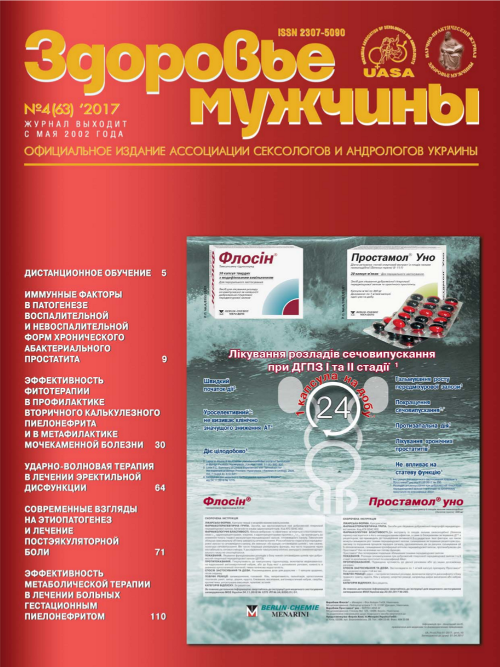Treatment of patients with oxalate urolithiasis after extracorporeal shock wave lithotripsy of ureteral calculi
##plugins.themes.bootstrap3.article.main##
Abstract
The frequency of recurrence of urolithiasis within the first 3 years after treatment reaches 53%, of which more than half of cases are detected in the first year of follow-up. In the remote period of observation, the frequency of recurrent stone formation reaches 77%.
The objective: to evaluate the metaphylactic effect of phytotherapy in patients with oxalate urolithiasis after extracorporeal shock wave lithotripsy (ESWL) of the ureteral calculi.
Materials and methods. The clinical study was conducted as a non-interventional open controlled, in two groups of patients with initial state control. The study included 64 patients with urolithiasis, oxalate concreting ureter, who performed one session of ESWL and achieved complete fragmentation of the stone. All patients of the main group (n = 32) were prescribed basic therapy + herbal medicine for 1 month with a repeat treatment at 6 months. Patients of the control group (n = 32) received baseline therapy without the study drug. The duration of follow-up is 12 months.
Results. After 12 months of observation in the patients of the main group, the concentration of citrates in the urine was 2.67 ± 0.14 mmol / L compared with 2.32 ± 0.11 mmol / L in the control group (p <0.05). In patients of the main group, the daily excretion of oxalates after 12 months of observation was reduced to 38.4 ± 3.45 mg / d compared with the control group patients - 50.1 ± 2.56 mg / d (p <0.05). After 12 months of observation, a consistently high diuresis was noted in the patients of the main group 1.96 ± 0.24 l / d compared with patients of the control group 1.62 ± 0.12 l / d (p <0.05). The concentration of uric acid in the urine of the patients of the main group decreased to 4.42 ± 0.27 mmol / L, in patients of the control group - up to 4.59 ± 0.22 mmol / l. After 12 months of observation, the serum uric acid concentration was 0.210 ± 0.64 ?mol / l in patients of the main group and 0.305 ± 0.73 ?mol / l in the control group (p <0.05).
Conclusion. Results of examination after 12 months of metaphylactic treatment of patients of the main group with oxalate nephrolithiasis showed no recurrent stone formation, in the control group 3 (9.4%) of the patient with recurrent formation of concrements up to 5 mm in the pulmonary calcification system of the kidney (p <0.05 ). The obtained results confirm the pathogenetic mechanisms of the action of phytopreparation Urolesan® on risk factors for oxalate nephrolithiasis, which is manifested in the stable normalization of the risk factors of this pathology
##plugins.themes.bootstrap3.article.details##

This work is licensed under a Creative Commons Attribution 4.0 International License.
Authors retain the copyright and grant the journal the first publication of original scientific articles under the Creative Commons Attribution 4.0 International License, which allows others to distribute work with acknowledgment of authorship and first publication in this journal.
References
Возіанов С.О. Урологія (підручник для лікарів-інтернів) / Возіанов С.О., Шуляк О.В., Банира О.Б. // Видавництво «Кварт», Львів, 2012. – 521 с.
Кушніренко С.В. Кристалурії в практиці сімейного лікаря // Сімейна медицина. – 2014. – № 6. – С. 36–38.
Методичні рекомендації. Сечокам’яна хвороба, дисметаболічна нефропатія, кристалурія. Методичні рекомендації / Іванов Д.Д., Возіанов С.О., Кушніренко С.В. та ін. – К., 2014. – 36 с.
Сагалевич А.И., Деркач И.А., Шапаренко Э.В., Лоскутов А.Е. и др. Малоинвазивные методы лечения двустороннего нефролитиаза // Урологія. – 2010. – Т. 14, додаток. – С. 260–262.
Aboumarzouk O.M. et al. Flexible ureteroscopy and holmium:YAG laser lithotripsy for stone disease in patients with bleeding diathesis: a systematic review of the literature. Int Braz J Urol, 2012. 38: 298.
American Association of Urology 2016, 2017 Guidelines on urolithiasis // EAU, 2016, 2017.
BUTZ M. Oxalatsteinprophylaxe durch Alcalitherapie. Urology A 21, 142 (2012).
BUTZ M. Rational prevention of calcium urolithiasis. Urol.lnt. 41,387 (2013).
Dell’Orto V.G. et al. Metabolic disturbances and renal stone promotion on treatment with topiramate: a systematic review. Br J Clin Pharmacol, 2014. 77: 958.
European Association of Urology 2016, 2017 Guidelines on urolithiasis // EAU, 2016, 2017.
Hara A. et al. Incidence of nephrolithiasis in relation to environmental exposure to lead and cadmium in a population study. Environ Res, 2016. 145: 1.
Pickard R. et al. Medical expulsive therapy in adults with ureteric colic: a multicentre, randomised, placebo-controlled trial. Lancet, 2015. 386: 341.
Rendina D. et al. Metabolic syndrome and nephrolithiasis: a systematic review and meta-analysis of the scientific evidence. J Nephrol, 2014. 27: 371.
Turk C. et al. EAU Guidelines on Diagnosis and Conservative Management of Urolithiasis. Eur Urol, 2016. 69: 468.
Yasui T. et al. 2082 Association of the loci 5q35.3, 7q14.3, and 13.q14.1 with urolithiasis: A case-control study in the Japanese population, involving genome-wide association study. J Urol, 2013. 189: e854.





